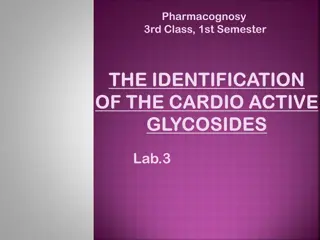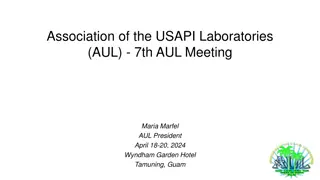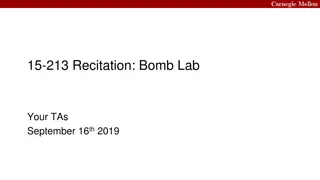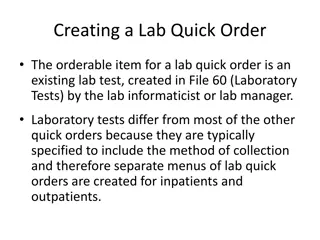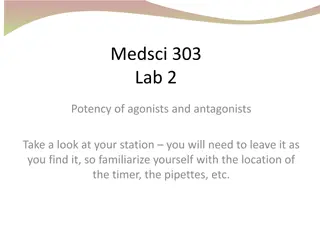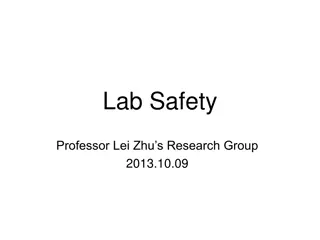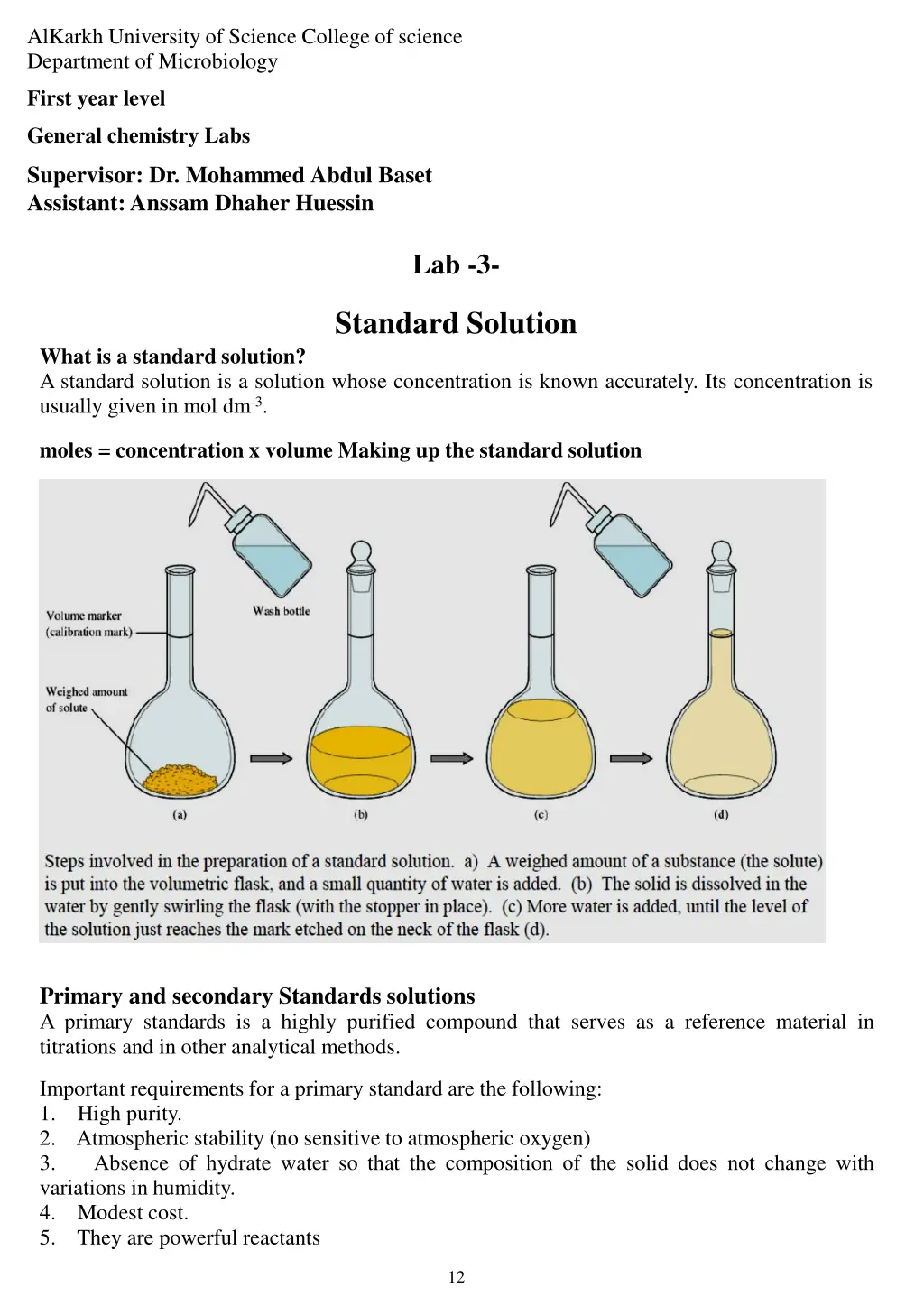
Understanding Standard Solutions in Chemistry
Explore the concept of standard solutions in chemistry, including primary and secondary standards, solute, solvent, types of standard solutions (Molarity, Normality), preparation techniques, and dilution processes. Gain insights into the importance of accurate concentrations and the role of analytical balances in creating standard solutions.
Download Presentation

Please find below an Image/Link to download the presentation.
The content on the website is provided AS IS for your information and personal use only. It may not be sold, licensed, or shared on other websites without obtaining consent from the author. If you encounter any issues during the download, it is possible that the publisher has removed the file from their server.
You are allowed to download the files provided on this website for personal or commercial use, subject to the condition that they are used lawfully. All files are the property of their respective owners.
The content on the website is provided AS IS for your information and personal use only. It may not be sold, licensed, or shared on other websites without obtaining consent from the author.
E N D
Presentation Transcript
AlKarkh University of Science College of science Department of Microbiology First year level General chemistry Labs Supervisor: Dr. Mohammed Abdul Baset Assistant: Anssam Dhaher Huessin Lab -3- Standard Solution What is a standard solution? A standard solution is a solution whose concentration is known accurately. Its concentration is usually given in mol dm-3. moles = concentration x volume Making up the standard solution Primary and secondary Standards solutions A primary standards is a highly purified compound that serves as a reference material in titrations and in other analytical methods. Important requirements for a primary standard are the following: 1. High purity. 2. Atmospheric stability (no sensitive to atmospheric oxygen) 3. Absence of hydrate water so that the composition of the solid does not change with variations in humidity. 4. Modest cost. 5. They are powerful reactants 12
6. They have known formula and molecular weight 7. They are usually high molecular weight compounds Secondary standard solution: A secondary standard solution is the one that must be standardized before use. This is because a secondary standard solution is not in its stable form. An example is the solution of NaOH. Secondary standards are 1. Influenced by atmosphere/environment 2. Concentration change over time 3. Usually powerful reactants 4. Usually cheap & easy to use Solute - The substance which dissolves in a solution. Solvent - The substance which dissolves another to form a solution. Solution - A mixture of two or more pure substances. Types of standard solutions: 1. Molarity: M = moles of solute contained in one liter of solution. Molarity = M = moles of solute/ Volume of solution = moles/L 2. Normality: N= moles of reactive units per liter (equivalents per liter) (1000)(grams of solute) N (equivalent wt. of solute)(ml of solution) Relationship between N and M N = n x M Where N is normality, M is morality and n is number of equivalents. Prepare (0.1 M) of sodium hydroxide Measuring Mass using an analytical Balance 1. Turn on balance and wait for display to read 0.0000 g. 2. Check the level indicator & do not lean on table while weighing. 3. Place weighing vessel on the balance pan (e.g., creased weighing paper, weigh boat) 4. Close the sliding doors & wait for stability light indicator, indicating that the weight is stable. 5. Press tare button so that display reads 0.0g. 13
6. Gently add the substance being weighed to the weighing sample. 7. Record mass. 8. Remove weighed sample. Clean spills off balance with brush or absorbent laboratory tissue. Discard any disposable weighing vessel Making up the solution 1. Take a watch glass and put it onto analytical balance on zero pointer. 2. Weight g from the sodium hydroxide, then transfer it into clean beaker. 3. Add small amount of distill water in the beaker and stirrer the solution by glass rod, until dissolve all crystal. 4. Transfer the solution carefully to volumetric flask (100 or 250 mL). 5. Wash the beaker 3 times with dist. water and transfer them to the volumetric flask. 6. Add distill water to the volumetric flask up to mark, then cover it by stopper. 14
Lab -4- Preparation of standard solution from liquid solutions Diluting Solutions > Many laboratory chemicals such as acids are purchased as concentrated solutions (stock solutions). > More dilute solutions are prepared by taking a certain quantity of the stock solution and diluting it with water. > A standard solution is one with an accurate, known concentration. This is also known as a stock solution. These are used as reactant solutions. They usually have a higher concentration than is needed for creating solutions and therefore must be diluted. > After diluting a solution, the concentration of the solution changes. > Relationship between molarity, density and weight percent is: Where M: molarity (mol/L), d: density (g/ml), Wt: weight percent (%) and Mw: molecular weight. > When a solution is diluted, the concentration of the new solution can be found using: Don t forget the equation for molar concentration! (c = n/V) C = concentration in moles per litre n = number of moles V = volume in litres How to make 0.1 M Sulfuric Acid (H2SO4) Solution from concentrated one 15
- Use a pipet to deliver a volume (Vx) of the concentrated solution (H2SO4) (Mx) to prepare (diluted) 100, 250 and 500 ml of 0.1 M sulfuric acid solution. - Add solvent (distilled water) to the line on the neck of the volumetric flask. - Mix well. - Mathematically the relationship of diluting solution can be shown in the equation: M(C), x V = M(C)2 x V 1 = initial (concentrated) 2 = final (diluted) Where: M(C)1= Initial concentration or molarity M (mol/L). V1 = Initial volume (ml) M(C)1= Final concentration or molarity M (mol/L). V1 = Final volume (ml) Why is acid always added to water, and not the reverse? o A large amount of heat is released when strong acids are mixed with water. Adding more acid releases more heat. o If you add water to acid, you form an extremely concentrated solution of acid initially. So much heat is released that the solution may boil very violently, splashing concentrated acid out of the container! o If you add acid to water, the solution that forms is very dilute and the small amount of heat released is not enough to vaporize and spatter it. So Always Add Acid to water, and never the reverse. 16

